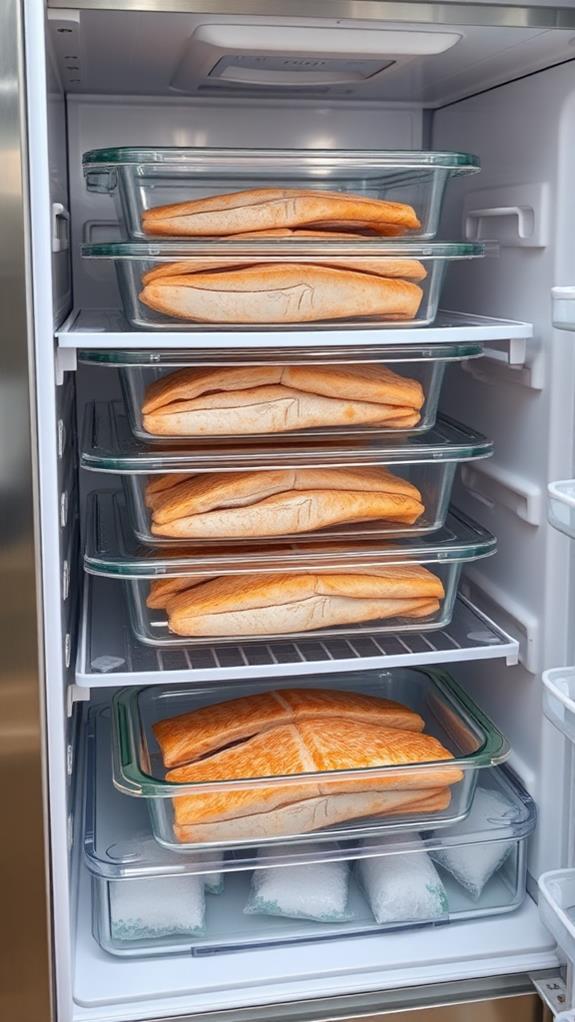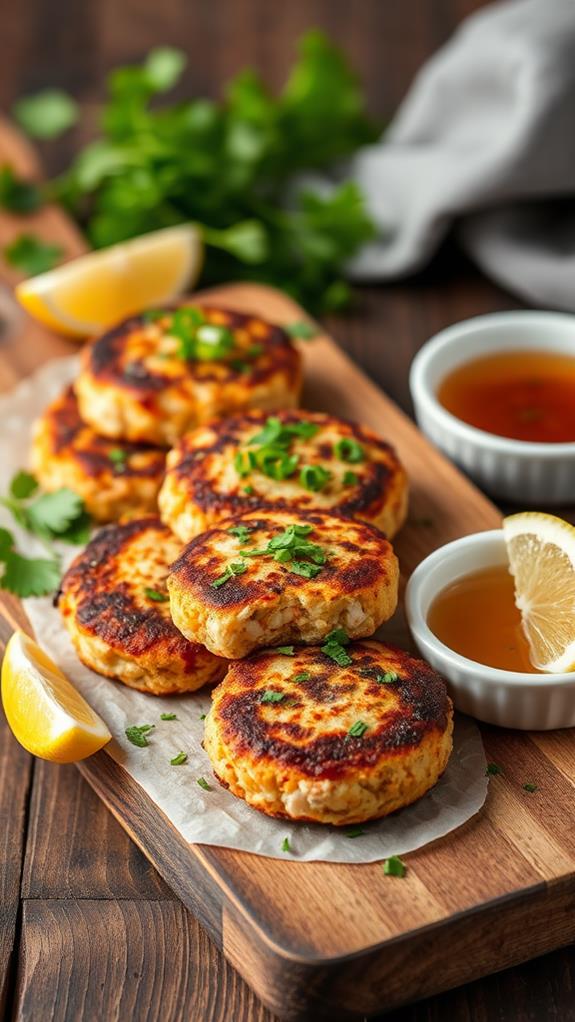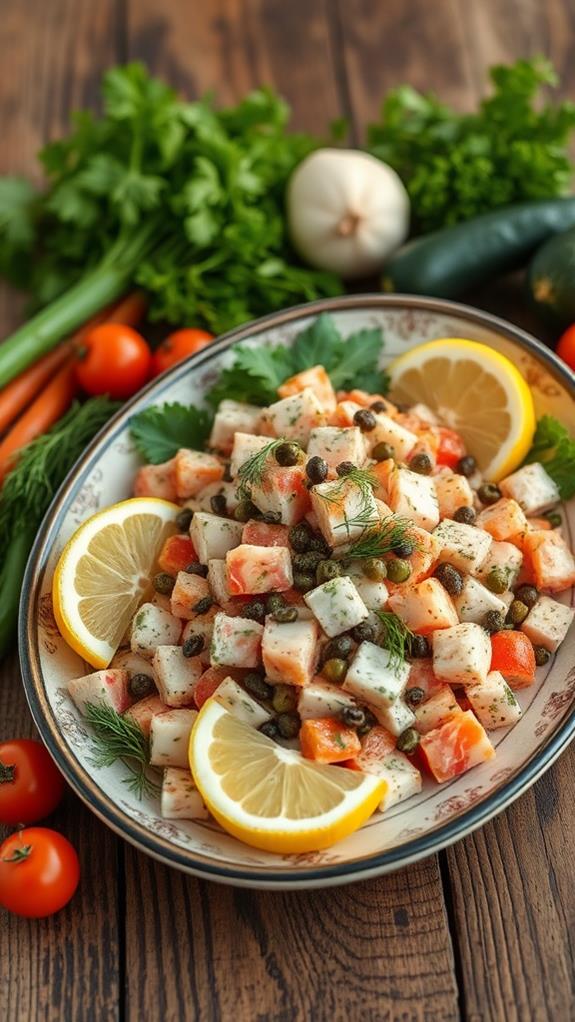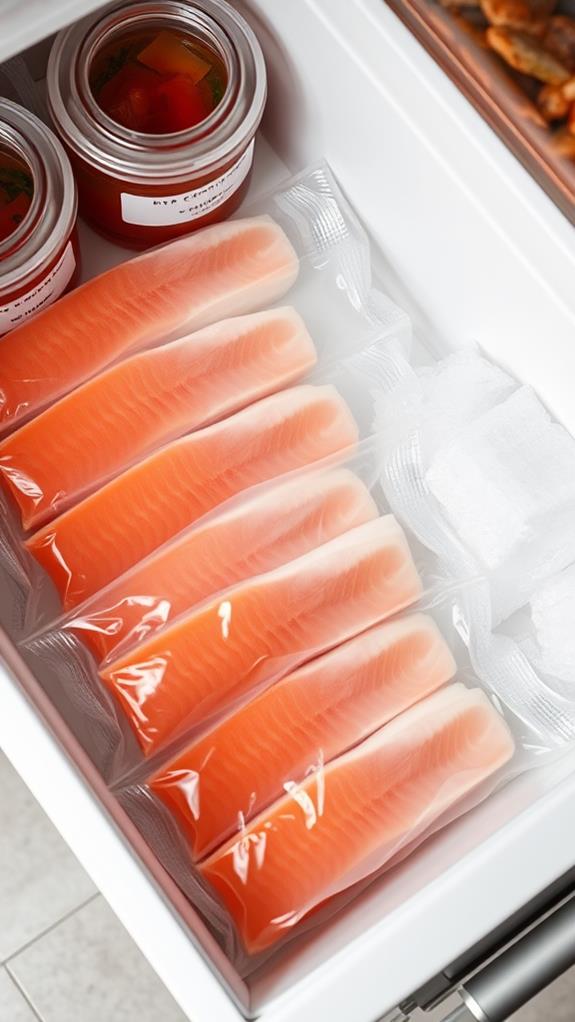What to Do With Leftover Fish
When you're faced with leftover fish, you have numerous options to transform it into delicious new meals. Proper storage is vital: refrigerate cooked fish within 3-4 days or freeze for 2-3 months. For creative repurposing, flake the fish and add it to tacos, chowders, or fried rice. When reheating, avoid microwaving; instead, use brief, direct heat to maintain texture. For cold dishes, bring the fish to room temperature and incorporate it into salads or ceviche-style preparations. Consider preservation methods like poaching in oil or creating a salt rub to extend its usefulness. These techniques will help you minimize waste and maximize the potential of your leftover fish. Explore further to uncover even more innovative ideas for your seafood surplus.
This post may contain affiliate links. If you make a purchase through these links, I may earn a commission at no additional cost to you. Additionally, portions of this post may be generated using artificial intelligence (AI) technology. While we strive for accuracy, please be aware that AI-generated content may not always be perfect and should be fact-checked when necessary.
The Spatula Scoops
- Flake leftover fish into tacos, chowders, or soups for quick and flavorful meals.
- Create fish cakes by mixing flaked fish with eggs, breadcrumbs, and seasonings.
- Make a fish salad by combining flaked fish with mayo, celery, and herbs.
- Use leftover fish in fried rice with vegetables for a complete meal.
- Incorporate flaky fish into cold dishes like ceviche or homemade sushi rolls.
Proper Storage Techniques

Freshness is key when it comes to storing leftover fish. If you've cooked more than you can eat, proper storage techniques will help maintain quality and safety. For cooked fish, you've got a 3-4 day window to enjoy it when refrigerated. Make sure to wrap it well and place it in the coldest part of your fridge. If you're not planning to eat your leftover salmon within a day or two, consider freezing it. Properly wrapped, cooked fish can last 2-3 months in the freezer. When storing raw fish, always guarantee it reaches a safe internal temperature when cooking to prevent foodborne illnesses. Use a digital thermometer to check for doneness, as visual cues can be misleading.
For raw fish, time is of the essence. You should cook it within 1-2 days of purchase, keeping it in the coldest part of your refrigerator until then. If you've got leftover sushi, consume it within a day and refrigerate it within 2 hours to prevent strong fishy flavors from developing. Remember, fish left at room temperature for too long can spoil quickly. When reheating leftover fish, be aware that the oils can oxidize, intensifying the fishy flavor. To combat this, try squeezing fresh lemon juice over the fish before reheating. This simple trick can help refresh the taste and mask any overly fishy notes.
Creative Repurposing Ideas

Leftover fish often presents a culinary challenge, but with a bit of creativity, you can transform it into exciting new dishes. Don't let that fresh fish go to waste; instead, try these inventive ideas to repurpose your leftover cooked fish.
One simple way to use flaked leftover fish is by adding it to tacos, chowders, or soups. You can also create delicious fish cakes by combining the fish with eggs, breadcrumbs, and seasonings. For a protein-packed option, blend the fish with yogurt or crème fraîche to make a flavorful pâté.
Here's a quick reference table for more ideas:
| Dish Type | Ingredients | Preparation |
|---|---|---|
| Fish Salad | Leftover fish, olive oil, lemon juice | Flake fish, mix with dressing |
| Fried Rice | Flaked leftover fish, rice, vegetables | Stir-fry all ingredients together |
| Burritos | Leftover fish, tortillas, toppings | Wrap fish and toppings in tortilla |
These creative repurposing ideas not only help reduce food waste but also provide you with quick and flavorful meals. Whether you're in the mood for fish salad, pasta dishes, or simply reheated fish over vegetables, there's a delicious way to enjoy your leftover fish.
Reheating Methods

When it comes to reheating leftover fish, you'll want to use gentle methods to preserve its texture and flavor. Avoid quick microwave reheating or second pan-searing, as these can dry out your cooked fish. Instead, opt for brief, direct heat to maintain the fish's quality. Proper preparation techniques are vital for food safety, so make sure you store leftover fish below 40°F and reheat it thoroughly to minimize the risk of foodborne illnesses.
For salmon or other flaky fish, try incorporating it into dishes like fish cakes mixed with mashed potatoes. This approach is quick and easy, allowing you to repurpose your leftovers within half an hour. If you're reheating fish on its own, use medium heat and keep the process short to prevent overcooking.
Remember that leftover fish dishes won't behave the same way as the original preparation, so you'll need to adapt your approach. Utilize your leftover fish within a day or two for best results. As reheated fish may develop a stronger fishy flavor due to oil oxidation, be prepared to adjust your seasoning accordingly. By following these guidelines, you'll be able to enjoy your leftover fish while maintaining its texture and taste, making the most of your seafood meals.
Cold Dish Transformations

Transform your chilled fish into delectable cold dishes without ever turning on the stove. Using leftover fish in cold preparations not only saves time but also preserves its delicate texture. To use up leftover fish effectively, make sure it's brought to room temperature before incorporating it into your dish. This enhances its flavor and makes it easier to work with. For ideal portion control and to reduce food waste, consider using silicone freezing trays to store individual servings of your leftover fish for future use.
Fish salad: Flake the fish and mix with mayo, celery, and fresh herbs.
Ceviche-style dish: Toss with citrus juice, onions, and peppers.
Sushi rolls: Use thinly sliced fish in homemade sushi.
Pâté spread: Blend with cream cheese and seasonings for a tasty spread.
When creating these cold fish dishes, focus on complementary flavors. A zesty sauce can elevate your leftover fish, while fresh herbs add brightness. Remember to handle the fish carefully to maintain its texture. By repurposing your leftovers creatively, you'll reduce food waste and enjoy a variety of appetizing meals. These cold transformations offer an invigorating twist on your original fish dish, perfect for warm days or light lunches.
Preservation and Extended Use

How can you make your leftover fish last longer? Preserving your catch can extend its shelf life and open up a world of culinary possibilities. One effective method is poaching your leftover salmon filet in oil, broth, or water. This technique not only preserves the fish but also allows for versatile use in various dishes.
For raw fish, try a light salt rub to cure it, stopping bacterial growth and creating a convenient protein source. Combine your preserved fish with homemade aioli, lemon zest, and fresh herbs for a flavorful condiment. This mixture can elevate fish cakes or serve as a dip for vegetables.
| Preservation Method | Best Fish Type | Serving Suggestion | Complementary Sauce |
|---|---|---|---|
| Oil Poaching | Caught Salmon | Grain Bowls | Lemon Aioli |
| Salt Curing | Mackerel | Rice Paper Rolls | Soy Sauce |
| Broth Poaching | Tuna | Pasta Dishes | Peanut Sauce |
| Water Poaching | Bluefish | Salads | Herb Dressing |
Utilizing preserved fish in salads, pastas, or sandwiches reduces food waste and enables strategic meal planning. Don't forget to incorporate ingredients like chopped celery for added crunch and freshness in your preserved fish dishes.
Frequently Asked Questions
How to Use Already Cooked Fish?
You've got plenty of options for using already cooked fish. Flake it and add it to tacos, chowders, or soups for extra flavor and protein. Mix it with eggs and breadcrumbs to make fish cakes. Create a tasty spread by mashing it with yogurt or cottage cheese. Incorporate it into rice dishes like kedgeree. When reheating, use gentle methods like simmering or steaming to avoid drying it out. These techniques will help you transform your leftover fish into delicious new meals.
Can Fish Be Eaten as Leftovers?
Like a second chance at life, leftover fish can indeed be eaten. You've got a 3-4 day window to enjoy cooked fish from your fridge, or 2-3 months if frozen. It's safe to reheat, but be aware that the fishy flavor might intensify. To keep things interesting, you can repurpose your leftovers into new dishes like fish cakes or tacos. Remember, though, that raw fish and sushi have shorter lifespans, so consume those within a day for safety.
Can You Save Leftover Cooked Fish?
Yes, you can save leftover cooked fish. It's important to refrigerate it within two hours of cooking to maintain food safety. You'll want to store it in an airtight container or wrap it tightly in plastic wrap or aluminum foil. Properly stored, your leftover fish will last 3-4 days in the refrigerator. If you won't eat it within that time, you can freeze it for up to 2-3 months. When reheating, use gentle heat to preserve its texture and flavor.
What Can I Do With Leftover Fish Parts?
One man's trash is another man's treasure, especially when it comes to leftover fish parts. You can use them to make fish stock, a flavorful base for soups and sauces. Grind them up to create fish meal for your garden, providing nutrient-rich fertilizer. You can also use fish scraps as bait for fishing or crab traps. If you're feeling creative, try making fish leather from the skin. Don't let these valuable bits go to waste!





